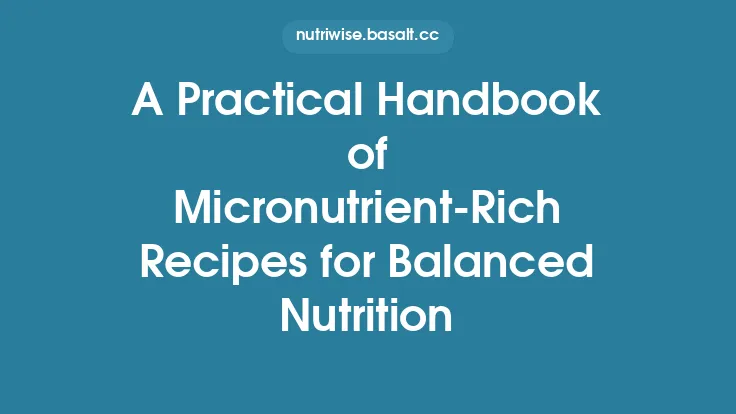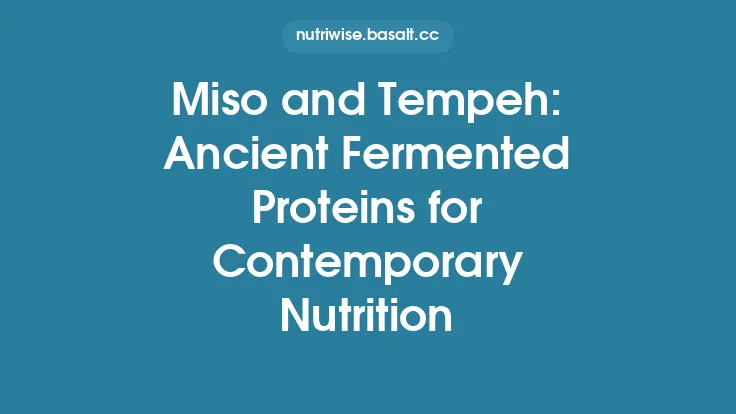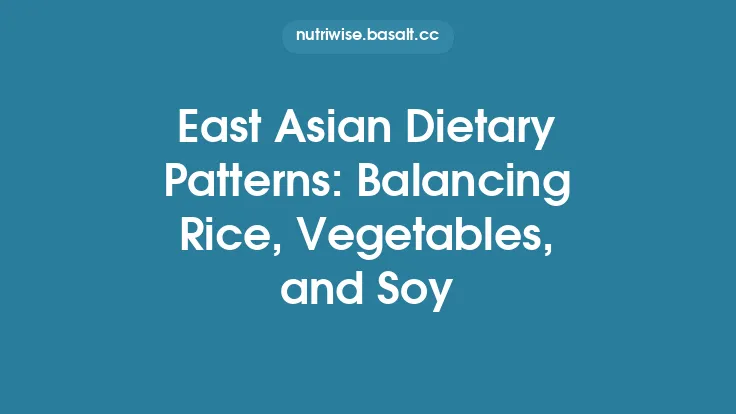Soy has been a cornerstone of plant‑based diets for centuries, prized not only for its versatility in the kitchen but also for its dense nutritional package and relatively low environmental footprint. When it comes to building a balanced, sustainable eating pattern, three soy derivatives—tofu, tempeh, and edamame—stand out as reliable sources of protein, essential micronutrients, and functional food components. This article delves into the science behind each product, explores practical ways to incorporate them into everyday meals, and examines the broader sustainability and ethical dimensions of soy production.
Nutritional Profile of Soy Products
All three soy foods share a core set of nutrients, yet each brings unique strengths:
| Nutrient (per 100 g) | Tofu (firm) | Tempeh | Edamame (cooked) |
|---|---|---|---|
| Calories | 76 kcal | 192 kcal | 122 kcal |
| Protein | 8 g | 19 g | 11 g |
| Total Fat | 4.8 g | 10.8 g | 5.2 g |
| Saturated Fat | 0.7 g | 2.0 g | 0.6 g |
| Carbohydrates | 1.9 g | 9.4 g | 9.9 g |
| Fiber | 0.3 g | 5.4 g | 5.2 g |
| Calcium* | 350 mg | 184 mg | 63 mg |
| Iron | 1.6 mg | 2.7 mg | 2.3 mg |
| Magnesium | 30 mg | 81 mg | 64 mg |
| Potassium | 121 mg | 410 mg | 436 mg |
| Vitamin B12** | 0 µg | 0 µg | 0 µg |
| Isoflavones (daidzein, genistein) | 20–30 mg | 30–45 mg | 15–25 mg |
\* Calcium values assume calcium‑set tofu; other varieties contain less.
\** Naturally, soy does not provide vitamin B12; fortified products or supplements are needed for vegans.
Key takeaways:
- Complete protein – Soy contains all nine essential amino acids in ratios comparable to animal proteins, making it a rare plant source that does not require complementary foods for protein completeness.
- Healthy fats – The majority of soy fat is polyunsaturated, including omega‑6 linoleic acid and modest amounts of omega‑3 α‑linolenic acid.
- Micronutrient density – Calcium‑set tofu can rival dairy for calcium, while tempeh’s fermentation boosts bioavailable iron and magnesium.
- Phytonutrients – Isoflavones act as mild estrogenic compounds and antioxidants, contributing to cardiovascular and bone health when consumed in moderation.
Tofu: Types, Production, and Culinary Applications
From Soybeans to Curds
Tofu (bean curd) is produced by coagulating soy milk with a coagulant—commonly calcium sulfate (gypsum), magnesium chloride (nigari), or glucono‑δ‑lactone (GDL). The curds are pressed into blocks of varying firmness:
| Firmness | Typical Pressing Time | Ideal Uses |
|---|---|---|
| Silken | 0–15 min (no pressing) | Smooth sauces, desserts, dressings |
| Soft | 15–30 min | Soups, gentle stir‑fries |
| Firm | 30–45 min | Grilling, baking, pan‑frying |
| Extra‑firm | 45–60 min | Crumbling, deep‑frying, kebabs |
The choice of coagulant influences texture and mineral content. Calcium sulfate adds calcium, while magnesium chloride contributes magnesium and a slightly sweeter flavor.
Cooking Techniques
- Marinating – Because tofu is porous, a brief soak (15–30 min) in a soy‑based, acidic, or umami‑rich marinade infuses flavor without compromising its delicate structure.
- Pressing – For firmer varieties, pressing out excess water (using a tofu press or weighted plates) improves browning and texture in high‑heat applications.
- Baking – Cubed firm tofu tossed with a thin coating of oil and spices, baked at 200 °C for 20–30 min, yields a crisp exterior and a creamy interior—ideal for salads or grain bowls.
- Silken tofu desserts – Blended with fruit purées, sweeteners, and a touch of agar, silken tofu can replace dairy in mousse, cheesecake, or pudding.
Nutritional Tweaks
- Calcium enrichment – Opt for calcium‑set tofu when aiming to meet daily calcium needs without dairy.
- Low‑sodium options – Some commercial tofu is brined; rinsing or selecting “unsalted” varieties reduces sodium intake.
Tempeh: Fermentation, Texture, and Uses
The Fermentation Process
Tempeh originates from Indonesia, where cooked, de‑hulled soybeans are inoculated with *Rhizopus oligosporus* spores and incubated at 30–32 °C for 24–48 hours. The mycelium binds the beans into a dense, cake‑like matrix, creating a nutty, earthy flavor and a firm, chewy texture.
Nutritional Advantages of Fermentation
- Enhanced digestibility – Fermentation degrades antinutrients such as phytic acid, improving mineral absorption (especially iron and zinc).
- Probiotic potential – While most of the mycelium is killed during cooking, some live cultures may survive light steaming, offering modest gut‑health benefits.
- Higher protein density – Because tempeh retains the whole bean, it delivers roughly double the protein of tofu per gram of weight.
Culinary Strategies
| Method | Description | Ideal Pairings |
|---|---|---|
| Steaming | 10–15 min to soften and reduce bitterness before further cooking | Salads, grain bowls |
| Slicing & pan‑frying | Thin slices crisp quickly in a hot skillet with a splash of oil | Sandwiches, tacos |
| Marinating & grilling | Longer marination (30 min–2 h) penetrates the porous structure, yielding caramelized edges | BBQ skewers, kebabs |
| Crumbling | Similar to ground meat, tempeh can be crumbled and sautéed with aromatics | Bolognese, chili, “scramble” dishes |
Tempeh’s robust flavor stands up well to bold sauces—think miso glaze, smoky chipotle, or sweet‑sour tamarind.
Edamame: Fresh, Frozen, and Snack Options
What Is Edamame?
Edamame are immature soybeans harvested while the pods are still green. They are typically boiled or steamed in salted water and served still in the pod, though shelled versions are also common.
Nutrient Highlights
- High fiber – The pod’s skin contributes insoluble fiber, supporting satiety and digestive health.
- Low glycemic impact – The carbohydrate profile, rich in resistant starch, leads to a modest post‑prandial glucose rise.
- Convenient micronutrients – Edamame supplies folate, vitamin K, and vitamin C (in the pod), making it a well‑rounded snack.
Practical Uses
- Snack – Lightly salted boiled pods are a portable, protein‑rich alternative to chips.
- Salad topper – Shelled edamame adds bite and protein to leafy greens, grain salads, and noodle bowls.
- Purees – Blended with tahini, lemon, and garlic, edamame becomes a vibrant dip or spread.
- Stir‑fries – Adding shelled edamame in the final minutes of cooking preserves texture and color.
Frozen edamame are pre‑blanched and retain most nutrients, offering year‑round accessibility.
Integrating Soy into Daily Meals
Breakfast
- Tofu scramble – Crumbled firm tofu sautéed with turmeric, nutritional yeast, and vegetables mimics scrambled eggs.
- Edamame‑avocado toast – Mashed avocado mixed with shelled edamame, lime, and chili flakes spreads over whole‑grain toast.
Lunch
- Tempeh Buddha bowl – Marinated tempeh cubes, roasted sweet potatoes, quinoa, kale, and a tahini‑lemon dressing.
- Miso‑tofu noodle soup – Silken tofu cubes in a broth flavored with miso, seaweed, and soba noodles.
Dinner
- Grilled tofu steaks – Pressed firm tofu marinated in soy‑ginger sauce, grilled, and served with a side of stir‑fried vegetables.
- Tempeh tacos – Crumbled tempeh seasoned with smoked paprika, topped with cabbage slaw and avocado crema.
Snacks & Desserts
- Edamame hummus – Blend edamame, olive oil, garlic, and lemon for a protein‑rich dip.
- Silken tofu chocolate mousse – Whisk silken tofu with melted dark chocolate, maple syrup, and a pinch of sea salt.
By rotating these three soy foods throughout the day, you achieve a balanced intake of protein, healthy fats, fiber, and micronutrients without relying on a single preparation method.
Sustainability and Ethical Considerations
Environmental Footprint
- Land use – Soybeans yield more protein per hectare than most other crops, reducing pressure on arable land.
- Water efficiency – While water needs vary by region, soy generally requires less irrigation than animal protein production.
- Greenhouse‑gas emissions – The carbon intensity of soy protein is roughly 1/10 that of beef, primarily because it bypasses enteric fermentation and manure management.
Ethical Sourcing
- Deforestation concerns – A significant portion of global soy cultivation occurs in South America, where expansion has contributed to forest loss. However, the majority of this soy is used for animal feed, not direct human consumption.
- Choosing responsibly – Look for certifications such as Non‑GMO Project Verified, USDA Organic, or Fair Trade. Some brands explicitly source soy from regions with stringent land‑use policies (e.g., the United States, Canada, Japan).
- Local and small‑scale producers – Purchasing tofu, tempeh, or edamame from local co‑ops or Asian markets often supports smaller farms with transparent practices.
Life‑Cycle Benefits
When soy is processed into tofu or tempeh, the energy input is modest compared to dairy or meat processing. Moreover, the by‑products (e.g., soy whey) can be repurposed as animal feed or fertilizer, creating a more circular food system.
Potential Concerns and How to Mitigate Them
| Concern | Explanation | Mitigation Strategies |
|---|---|---|
| Allergies | Soy is among the top eight allergens. | Read labels carefully; substitute with other legumes if needed. |
| Phytoestrogen intake | Isoflavones can mimic estrogenic activity. | Moderate consumption (1–2 servings/day) is safe for most adults; those with thyroid disorders should monitor iodine intake. |
| GMO prevalence | Over 90 % of soy grown in the U.S. is genetically modified. | Choose certified non‑GMO or organic products. |
| Antinutrients (phytic acid) | Can inhibit mineral absorption. | Fermentation (tempeh) and cooking (tofu, edamame) reduce phytic acid levels. |
| Sodium in processed soy | Some flavored tofu or tempeh contains added salt. | Opt for plain varieties and season at home. |
Practical Tips for Shopping, Storing, and Preparing
- Selection
- Tofu – Look for clear water, no off‑odors, and a firm texture if you plan to grill.
- Tempeh – Choose a solid, white cake with a pleasant nutty aroma; avoid mold beyond the typical white mycelium.
- Edamame – Fresh pods should be bright green and crisp; frozen bags should be free of ice crystals.
- Storage
- Tofu – Keep unopened packages refrigerated; once opened, submerge in fresh water, change daily, and use within 5 days.
- Tempeh – Store in the refrigerator for up to 10 days; freeze for longer shelf life (up to 6 months).
- Edamame – Fresh pods last 3–5 days in the fridge; frozen edamame can be kept for 12 months.
- Prep Hacks
- Pressing tofu – Use a tofu press or wrap in a clean towel, place a weight on top for 15–30 minutes.
- Steaming tempeh – A quick 10‑minute steam reduces bitterness and improves texture before marinating.
- Shelling edamame – Pinch the pod at the stem and pull; the beans pop out easily when cooked.
- Flavor Boosters
- Umami enhancers – Nutritional yeast, miso, tamari, and kombu broth amplify soy’s natural savoriness.
- Acid balance – A splash of rice vinegar, lime, or lemon brightens tofu and tempeh dishes.
- Spice layers – Toasted sesame oil, smoked paprika, or curry powder add depth without extra sodium.
Toward a Balanced, Sustainable Diet
Incorporating tofu, tempeh, and edamame into your meals offers a trifecta of benefits: high‑quality protein, a suite of essential micronutrients, and a relatively low environmental impact. By understanding each product’s unique characteristics—how they’re made, their nutritional nuances, and the best culinary techniques—you can craft meals that are both satisfying and nutritionally complete. Pair these soy foods with a diverse array of vegetables, whole grains, and healthy fats, and you’ll have a robust, plant‑forward diet that aligns with both personal health goals and broader sustainability imperatives.





